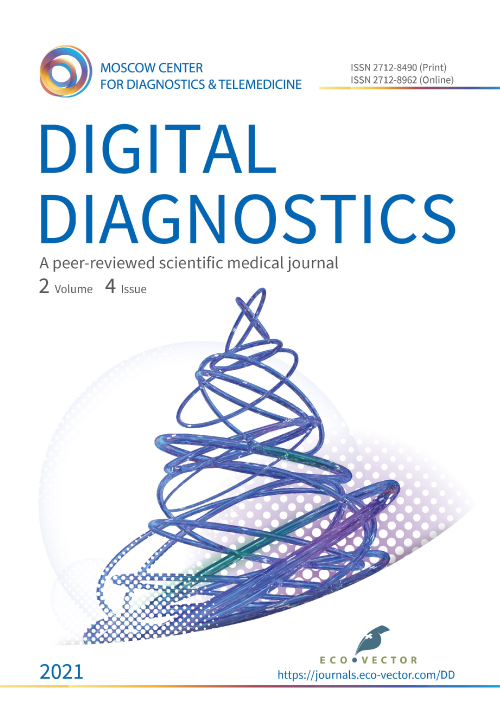包裹性坏死性胰腺炎
- 作者: Kitavina S.I.1, Petrovichev V.S.1, Ermakov A.N.2, Ermakov N.A.1, Nikitin I.G.1
-
隶属关系:
- Therapy and Rehabilitation Center
- Moscow State University of Medicine and Dentistry named after A.I. Evdokimov
- 期: 卷 2, 编号 4 (2021)
- 页面: 471-480
- 栏目: 临床病例及临床病例的系列
- ##submission.dateSubmitted##: 08.06.2021
- ##submission.dateAccepted##: 14.01.2022
- ##submission.datePublished##: 30.12.2021
- URL: https://jdigitaldiagnostics.com/DD/article/view/71156
- DOI: https://doi.org/10.17816/DD71156
- ID: 71156
如何引用文章
详细
坏死性胰腺炎或胰腺坏死是急性胰腺炎中最严重的一种,死亡率很高。最适合诊断急性胰腺炎的时期是从疾病症状开始的3—5天。在此期间,胰腺水肿和暂时性缺血可能伪装为坏死,并在后续研究中消失,反之亦然,局部并发症可能在没有临床相关性的情况下发生。
目前,在急性胰腺炎的治疗中,放射诊断方法越来越受到重视,尤其是计算机断层扫描,因为它可以更精确地测量胰腺容积、评估病情和测量脾静脉直径,这在未来可能对胰腺坏死过程的预后形成有重要影响。
这篇文章介绍了一个罕见的急性胰腺炎并发症的临床病例包裹性坏死性胰腺炎,它是在消化系统疾病的背景下出现的。本文介绍了放射诊断方法在这些病理学动态检查中的符号学方面。该病例值得注意的是,患者入院时的疾病表现与典型水肿型急性胰腺炎相当。在急性胰腺炎病程的临床和形态学阶段之间以及在胰腺坏死形成之前进行的一系列动态CT图像显示负动态进一步增加,并伴有胰腺体分离和胰旁脓肿形成,这使得最清楚地显示疾病的逐步发展成为可能。治疗模式发生了改变,保守治疗被积极的手术策略所取代,随后是反复操作、动态计算机断层扫描和磁共振控制,直到患者病情好转。
迄今为止,放射诊断方法结合适当的治疗和手术方法可以改善坏死性胰腺炎的预后。
全文:
绪论
坏死性胰腺炎是急性胰腺炎中最严重的一种,其致命性的发生率为30—100%[1—4]。坏死性胰腺炎,或胰脏坏死,发生在15—20%的急性胰腺炎[5]。急性胰腺炎在世界范围内的发病率为每10万人口4.9—73.4例,在俄罗斯为10—13%(在腹腔外科病理患者总数中)[6]。
国内主要科学家[7]和国外多名作者均阐述了放射诊断方法对胰腺坏死患者的疾病检测和治疗策略选择的重要性[8—11]。
目前,放射诊断方法在急性胰腺炎管理中的作用,特别是计算机断层扫描(CT),由于更精确的胰腺容量测量的可能性[12],评估和测量脾静脉的状况和直径,这可能在未来胰腺坏死预后的形成中起重要作用[13]。在坏死性胰腺炎中[14],最早研究CT数据显示骨骼肌密度的丧失与预后恶化的关系。
在亚特兰大关于急性胰腺炎的治疗过程和策略的最新建议中(美国,2012)1,有减少患者辐射负荷的趋势,主要依靠临床检查、超声和炎症生化标志物的数据,消除过多的影像学(CT和MRI), 从而减轻经济负担;除非诊断不明确或急性胰腺炎在48—72小时内病情恶化[15, 16]。然而,其他资料显示,超过一半的急性胰腺炎患者在临床上适合治疗,没有客观的影像学方法进行独立治疗[17]。当医生做出临床决定时,使用更新的诊断标准会带来额外的压力负荷[18]。随着时间的推移,亚特兰大急性胰腺炎分类的修订继续被使用,并发现在欧洲积极应用[19]。
1 急性胰腺炎亚特兰大分型。访问模式:https://medach.pro/post/1830访问日期:2021年10月15日
病例报告
H.患者,40岁,2018年1月13日,临床表现为急性胰腺炎和多器官衰竭,病情严重,紧急住院于重症监护病房。病人入院时主诉为上腹部剧烈疼痛、恶心、呕吐。
疾病回顾:患者在进食大量高脂肪食物(发育高分泌机制)后一天内发病;早上他感到上腹部剧烈疼痛,然后恶心、呕吐、腰部疼痛照射。救护队被送往俄罗斯卫生部(莫斯科)联邦国家自治机构国家医学研究中心治疗和康复中心的急诊科。
物理、实验室和仪器检查结果
在入院时,患者的情况被视为早期IA期。
2018年1月14日的多螺旋计算机断层扫描显示急性胰腺炎的图像;没有发现胰腺实质破坏的迹象(图 1)。
图 1静脉注射造影剂的腹部计算机断层扫描:胰腺周围脂肪组织的浸润和肝脏下间隙的脂肪组织(箭头)。
在重症监护室的两天里,患者接受了输液纠正、抗分泌、抗氧化、保肝、抗痉挛治疗;多模式镇痛;预防血栓栓塞并发症和胃肠减压。
2018年1月15日,患者转入医院综合科,患者主观上病情好转。当出现高达38°C的发烧时,开始了抗生素治疗。在肚脐左侧触诊到测量12×10 cm 的致密无痛浸润。临床上认为为急性胰腺炎IB期(胰腺周围浸润及吸收热形成期)的表现。
截至2018年1月22日,在患者病情稳定、体温正常化以及实验室和仪器研究数据的背景下,注意到腹膜后间隙局部炎症变化迹象增加。超声显示腹腔积液量增加,腹膜后间隙左半边脂肪组织(胰腺坏死)自吸。
该研究对胸部和腹部器官进行了CT扫描:双侧胸腔积液,左侧较多;左肺下叶实变;双肺基底部肺不张;破坏性胰腺炎:胰腺实质呈碎片状,动力学上可见头部增厚,液体积聚增多,腹腔和腹膜后间隙出现重量(图 2)。这些变化使得在IB结束时,即II期疾病(无菌隔离)开始时,评估临床和仪器图像成为可能。
图 2静脉注射造影剂的腹部计算机断层扫描:胰腺周围脂肪组织、左侧肾周围筋膜、胰头和胰体实质的浸润和液体积聚(箭头)。
考虑到患者胰腺组织无感染迹象,且临床表现良好,决定不进行手术干预。2018年1月24日,常规血液检测白细胞增多(从21.8降至16.9×109 g/L)和C反应蛋白(从206降至144 mL/L)浓度下降。但经过一段时间的临床改善后,患者入院第18天(2018年1月31日)病情急剧恶化:出现疼痛综合征,体温高达38°С伴寒战,腹膜症状可疑,白细胞增多,一般血检达31×109 g/L。
腹部对照超声显示腺体隔离和积聚大量液体周围;大网膜袋与腹腔的沟通,在所有科室都有不限量的纤维蛋白包体液体(容量至少1L);腔旁带腹膜后脂肪组织明显渗吸。因此,超声图像符合胰腺坏死引起的胰腺坏死性改变的进展,即胰腺旁脓肿的形成。
2018年1月31日,经过短期的术前准备,紧急进行了诊断性腹腔镜检查,对腹腔进行消毒和引流,然后转为开腹手术,形成网膜造口,以方便进入网膜进行非切除术。
术中诊断:严重急性胰腺炎。胰腺坏死,形成腹膜后液体积聚;败血症封存期。分散性胰源性浆液纤维蛋白性(酶性)腹膜炎。
2018年2月1日,腹部超声检查进一步发现右侧腹膜后间隙有7×4.5×15 cm的积液,与升结肠后壁紧密相邻。由于开放性引流过程中损伤结肠的风险很高,因此进行了超声引导下的引流,以防止结肠壁的坏死和腹膜后空间的感染。
术后出现心血管呼吸功能不全现象,于术后第2天(2018年2月2日)拔管。进行了综合治疗,取得了积极的效果:白细胞减少到一般血液计数的10×109 g/L,C反应蛋白持续升高(241 mg/L) 。此外,在一周内,患者每天进行伤口敷料,并对网膜囊造口进行监测和消毒。没有额外的伤口肿胀,在网膜囊造口监测期间发现游离隔离物。
腹腔对照CT扫描(从2018年2月1日、2018年2月2日、2018年2月5日)显示CT图像无负动态,网膜囊区域的胰腺和沿腺体轮廓的液体积聚无动态,腹膜后空间无未排泄的液体积聚 (图 3)。
图 3静脉注射造影剂的腹部计算机断层扫描:胰腺周围脂肪组织、左侧肾周围筋膜、胰头和胰体实质(箭头)的浸润和液体积聚;引流管(左侧图像中的人字形箭头)。在反复的分析中,注意到沿着渗透带形成了一层薄薄的对比囊。
术后第10天,当病人的病情稳定后,病人被转到外科。经过多次非切除手术后,在9天内建立了网膜囊腔的流动-抽吸引流。
根据对照CT检查胸部和腹部器官(从2018年2月14日、2018年2月18日),左侧胸水减少,左肺下叶实变区消退;胰腺周围组织积液减少,腹部脂肪浸润改变(图 4)。
图 4腹腔器官CT与静脉造影:胰腺周围脂肪组织的引流浸润和液体积聚,在复查中减少(左图,箭头),引流内容物的腔内有止血海绵;引流管(右图,人字形箭头)。在重复分析中,注意到沿着浸润区的路线进一步形成了一个薄的、对比强烈的囊状物。
在临床上,发现有一个胰腺外瘘。2018年2月28日进行了MR胆道造影:胰头和胰体水平的胰管未被发现,胰尾走向迂回,其轮廓不规则,直径2 mm,未发现瘘管通道。肝内和肝外胆管没有扩张(图 5)。
图 5磁共振成像胆道造影(左图)和 T٢-WI(冠状面,右图)。胆总管的远端部分在浸润中消失,胆总管的近端部分和肝内胆管没有淤塞(箭头)。
术后1个月进行保守治疗及大网膜袋引流。患者病情好转至满意,发热停止,并形成胰外瘘。病人在外科医生的监督下出院。
2018年3月23日的腹腔对照CT扫描显示,胰腺体前和尾部的浸润减少,沿升结肠的浸润减少;腺体大小减少:尾部的矢状面大小为17 mm,体前为6 mm,头部水平的腺体没有明显分化(图 6)。
图 6静脉注射造影剂的腹部计算机断层扫描:引流管(左图,箭头);引流管浸润和胰腺周围脂肪组织中的液体积聚,随时间推移而减少(右图,箭头)。
因此,对所示病例及时诊断,可选择最正确的治疗策略,改善了疾病的预后,急性期和亚急性期均较好结束。
讨论
L. Sorrentino等人[20]在治疗严重胰腺坏死的过程中,采用微创方法—内镜下胰腺坏死切除术(ETN — endoscopic pancreatic necrosectomy)。 在第一阶段,我们可以看到我们的治疗策略有相似之处:诊断性腹腔镜检查和腹腔引流,但在下一阶段,我们选择扩大手术干预,转为开腹手术,形成网膜胸腔,以方便进入网膜进行坏死性腹膜切除术。
一组来自日本的科学家描述了通过负压持续引流皮肤伤口和内镜下坏死切除联合治疗坏死性胰腺炎患者的良好效果[21]。另一例临床病例[22]显示Barrett食管壶腹部活检后发展为坏死性胰腺炎,随后在CT控制下对坏死性腔反复引流治疗。
在所有报告的临床病例中,包括我们的病例,除了临床和实验室资料外,CT和静脉造影积极用于诊断、评估疾病的病程和治疗策略的选择。
因此,急性胰腺炎最适合诊断的时间是从出现症状的72小时到5天。在此期间,胰腺水肿和一过性缺血可能以坏死的形式出现,并在随后的检查中得到解决,反之,局部并发症的发生可能与临床无关。本病例中的患者在持续严重的临床表现期间,表现出从疾病的IA期向IB期过渡。
根据临床建议,CT最适用于临床图像改变和/或患者病情急剧恶化时,以排除局部并发症的发展。在本例患者中,CT扫描对临床情况的变化很敏感,发现最初过渡到IIA期无菌性隔离,然后过渡到IIB期化脓性隔离,形成了胰腺旁脓肿。
在计划微创手术治疗坏死性胰腺炎时,CT是一项必要的研究,目前微创手术治疗坏死性胰腺炎的首选方法。这一策略被应用于我们研究的病人。
MRI是评估胰腺坏死的胆道和轮胆管的首选方法,这与我们在治疗坏死性胰腺炎期间出现胰腺外瘘的患者有很大关系。
结论
迄今为止,放射诊断方法结合适当的治疗和手术方法可以改善坏死性胰腺炎的预后。
附加信息
资金来源。作者声称这项研究没有资金支持。
利益冲突。作者声明,没有明显的和潜在的利益冲突相关的发表这篇文章。
作者的贡献。所有作者都确认其作者符合国际ICMJE标准(所有作者为文章的概念,研究和准备工作做出了重大贡献,并在发表前阅读并批准了最终版本)。
对文章的最大贡献分布如下:S.I.Kitavina — 负责准备和撰写这篇文章;V.S.Petrovichev — 负责撰写和编辑文章;A.N.Ermakov — 负责收集和分析文学资料,编辑说明性材料;N.A.Ermakov — 负责撰写文章的文字,准备说明性的材料;I.G.Nikitin — 负责文章编辑。
出版同意。作者在发表医疗数据和照片时获得了患者的书面同意。
谢意。作者对 Irina Ilyinichna Slutskaya 编辑文章文体的帮助表示感谢。
作者简介
Svetlana I. Kitavina
Therapy and Rehabilitation Center
Email: skitavina@yandex.ru
ORCID iD: 0000-0002-1280-1089
SPIN 代码: 9741-1675
MD, Cand. Sci. (Med.)
俄罗斯联邦, 3 Ivan’kovskoe shosse, 125367, MoscowVictor S. Petrovichev
Therapy and Rehabilitation Center
Email: petrovi4ev@gmail.com
ORCID iD: 0000-0002-8391-2771
SPIN 代码: 7730-7420
MD, Cand. Sci. (Med.)
俄罗斯联邦, 3 Ivan’kovskoe shosse, 125367, MoscowAleksandr N. Ermakov
Moscow State University of Medicine and Dentistry named after A.I. Evdokimov
Email: alx-ermakovv@yandex.ru
ORCID iD: 0000-0003-0675-8624
SPIN 代码: 9257-9319
MD
俄罗斯联邦, 3 Ivan’kovskoe shosse, 125367, MoscowNikolay A. Ermakov
Therapy and Rehabilitation Center
Email: n-ermakov@yandex.ru
ORCID iD: 0000-0002-1271-7960
SPIN 代码: 5985-9032
MD, Cand. Sci. (Med.)
俄罗斯联邦, 3 Ivan’kovskoe shosse, 125367, MoscowIgor G. Nikitin
Therapy and Rehabilitation Center
编辑信件的主要联系方式.
Email: igor.nikitin.64@mail.ru
ORCID iD: 0000-0003-1699-0881
SPIN 代码: 3595-1990
MD, Dr. Sci. (Med.), Professor
俄罗斯联邦, 3 Ivan’kovskoe shosse, 125367, Moscow参考
- Volkov V, Chesnokova N. Acute necrotizing pancreatitis: Actual questions of classification, diagnosis and treatment of local and widespread purulent-necrotic processes. Bulletin Chuvash University. 2014;(2):211–217. (In Russ).
- Bagnenko SF, Gol’tsov VR. Acute pancreatitis: current state of the problem and unresolved issues. Almanac A.V. Vishnevsky Ins Sur. 2008;3(3):104–112. (In Russ).
- Banks PA, Bollen TL, Dervenis C, et al. Classification of acute pancreatitis-2012: revision of the Atlanta classification and definitions by international consensus. Gut. 2013;62(1):102–111. doi: 10.1136/gutjnl-2012-302779
- Petrov MS, Shanbhag S, Chakraborty M, et al. Organ failure and infection of pancreatic necrosis as determinants of mortality in patients with acute pancreatitis. Gastroenterology. 2010;139(3):813–820. doi: 10.1053/j.gastro.2010.06.010
- Acute pancreatitis. Clinical recommendations of the Ministry of Health of the Russian Federation. Moscow, 2015. (In Russ). Available from: http://общество-хирургов.рф/upload/acute_pancreatitis_2016.doc. Accessed: 15.10.2021.
- Podoluzhny VI, Aminov IH, Rodionov IA. Acute pancreatitis. Kemerovo: POLIGRAF; 2017. 136 р. (In Russ).
- Bagnenko SF, Savello VE, Goltsov VR. Radiation diagnosis of pancreatic diseases: acute pancreatitis. In: Radiation diagnostics and therapy in gastroenterology: national guidelines. Ed. by G.G. Karmazanovsky Moscow: GEOTAR-Media; 2014. P. 349–365. (In Russ).
- Branco JC, Cardoso MF, Lourenço LC, et al. A rare cause of abdominal pain in a patient with acute necrotizing pancreatitis. GE Port J Gastroenterol. 2018;25(5):253–257. doi: 10.1159/000484939
- Zhang H, Chen G, Xiao L, et al. Ultrasonic/CT image fusion guidance facilitating percutaneous catheter drainage in treatment of acute pancreatitis complicated with infected walled-off necrosis. Pancreatology. 2018;18(6):635–641. doi: 10.1016/j.pan.2018.06.004
- Sahu B, Abbey P, Anand R, et al. Severity assessment of acute pancreatitis using CT severity index and modified CT severity index: Correlation with clinical outcomes and severity grading as per the Revised Atlanta Classification. Indian J Radiol Imaging. 2017;27(2):152. doi: 10.4103/ijri.IJRI_300_16
- Shahzad N, Khan MR, Inam Pal KM, et al. Role of early contrast enhanced CT scan in severity prediction of acute pancreatitis. J Pak Med Assoc. 2017;67(6):923–925.
- Avanesov M, Löser A, Smagarynska A, et al. Clinico-radiological comparison and short-term prognosis of single acute pancreatitis and recurrent acute pancreatitis including pancreatic volumetry. PLoS ONE. 2018;13(10):e0206062. doi: 10.1371/journal.pone.0206062
- Smeets XJ, Litjens G, da Costa DW, et al. The association between portal system vein diameters and outcomes in acute pancreatitis. Pancreatology. 2018;18(5):494–499. doi: 10.1016/j.pan.2018.05.007
- Van Grinsven J, van Vugt JLA, Gharbharan A, et al.; Dutch Pancreatitis Study Group. The association of computed tomography-assessed body composition with mortality in patients with necrotizing pancreatitis. J Gastrointest Surg. 2017;21(6):1000–1008. doi: 10.1007/s11605-016-3352-3
- Colvin SD, Smith EN, Morgan DE, et al. Acute pancreatitis: an update on the revised Atlanta classification. Abdom Radiol. 2020;45(5):1222–1231. doi: 10.1007/s00261-019-02214-w
- Baker ME, Nelson RC, Rosen MP, et al. Acr appropriateness Criteria acute pancreatitis. Ultrasound Quarterly. 2014;30(4):267–273. doi: 10.1097/RUQ.0000000000000099
- Shinagare AB, Ip IK, Raja AS, et al. Use of CT and MRI in emergency department patients with acute pancreatitis. Abdom Imaging. 2015;40(2):272–277. doi: 10.1007/s00261-014-0210-1
- Jin DX, McNabb-Baltar JY, Suleiman SL, et al. Early abdominal imaging remains over-utilized in acute pancreatitis. Dig Dis Sci. 2017;62(10):2894–2899. doi: 10.1007/s10620-017-4720-x
- Schreyer AG, Seidensticker M, Mayerle J, et al. Deutschsprachige terminologie der revidierten atlanta-klassifikation bei akuter pankreatitis: glossar basierend auf der aktuellen S3-Leitlinie zur akuten, chronischen und Autoimmunpankreatitis. Rofo. 2021;193(08):909–918. doi: 10.1055/a-1388-8316
- Sorrentino L, Chiara O, Mutignani M, et al. Combined totally mini-invasive approach in necrotizing pancreatitis: a case report and systematic literature review. World J Emerg Surg. 2017;12:16. doi: 10.1186/s13017-017-0126-5
- Namba Y, Matsugu Y, Furukawa M, et al. Step-up approach combined with negative pressure wound therapy for the treatment of severe necrotizing pancreatitis: a case report. Clin J Gastroenterol. 2020;13(6):1331–1337. doi: 10.1007/s12328-020-01190-9
- Skelton D, Barnes J, French J. A case of severe necrotising pancreatitis following ampullary biopsy. Ann R Coll Surg Engl. 2015;97(4):e61–e63. doi: 10.1308/003588415X14181254789646
补充文件



















